By Lindsey Breunig
About a year ago we highlighted the Better Living for Texans program, and today we are returning to give you program updates and highlights! (Don’t worry, next month we will back to our regularly scheduled green veggie recipes!) Better Living for Texans (BLT) is a statewide nutrition education program within the Texas A&M AgriLife Extension Service (Texas A&M AgriLife). The program is for adults and children that are part of the Supplemental Nutrition Assistance Program and/or SNAP eligible.
Statistics show that 1 out of 6 Texans struggle with food insecurity, hunger, and eat less than the daily recommended allowance of fruits and vegetables. Additionally, Texas children and adults are less physically active than recommended. McLennan County is no exception and it is critical that we change these statistics in a positive direction.
BLT’s focus is to teach people how to prepare healthy meals, improve their physical fitness, save money at the grocery store, grow their own foods, and adopt better food safety habits. We provide facts and not the latest trends. BLT is here to empower individuals, families, and communities to make positive changes for healthier lives on limited resources.
Program delivery varies between location and audience. You may see BLT programming at health fairs, community centers, food pantries, or church events! Additionally, groups or participants may request for programs with a group they know or work with. From there we can choose from several available curriculums and tailor the program to fit the audience needs. If there is an interest in health and wellness, we are there!
Program Highlights:
At our programs we want healthy eating to be practical and attainable to everyone. We are here to challenge the notion that “it’s too expensive to eat healthy.” We are excited to also offer a curriculum specifically for seniors where we discuss steps to remain independent by choosing healthy diets and staying physically active.

If you want to focus on physical activity, we have fitness programs that encourage individuals to find their favorite activity and get moving. For example, we offer “Walk and Talks” that combine walking and learning. We also coordinate “Walk Across Texas” an eight week program that encourages teams made of family, friends, and coworkers to log their exercise with the goal to walk across Texas.
Maybe you have always wanted to garden, but you don’t know how to get started. Our gardening curriculum begins at the basics. Education includes how to select a garden location, how to compost, plant and water, and control insects. Participants learn how to grow fruits and vegetables and learn how to cook with produce grown from their own garden. The BLT program relies on the knowledge from the numerous Master Gardeners (another Texas A&M AgriLife program!) here in Waco. They are a great resource for learning how to grow fruits and vegetables!
Overall BLT is here to make health attainable and practical for all. This is done through providing research and evidence-based nutrition, health and wellness knowledge to empower individuals, families, and communities to make positive changes for healthier lives. BLT creates opportunities, and changes lives.
If you are interested or want to know more about the Better Living for Texans program here in McLennan County, please do not hesitate to reach out, and ask. We would love to get involved with your group or organization!
You can call the County Extension office and ask for Lindsey at: 254-757-5180 or directly email [email protected].
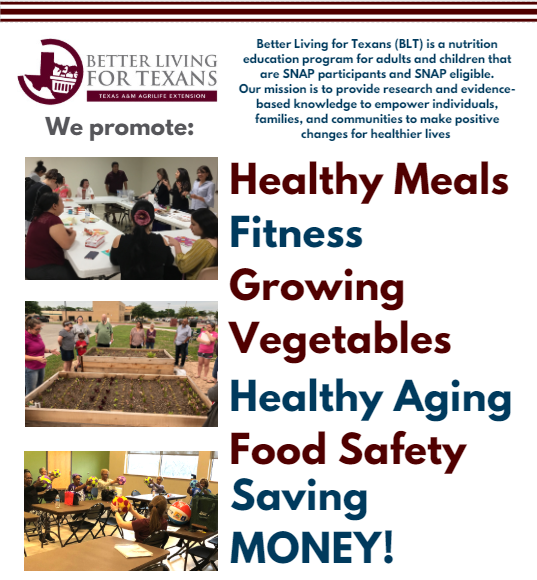

Lindsey Breunig is a graduate of Baylor University and currently works as the Better Living for Texans Educator for the Texas A&M AgriLife Extension Service. She is originally from Grapevine, TX and now calls Waco home. Here in Waco she loves to venture out to Cameron Park, visit the local Farmers Market, and try out the awesome eateries in Waco. If you see her and hear a loud bark, that’s her pup Lucy just saying hello.
USDA is an equal opportunity provider and employer. This material was funded by USDA’s Supplemental Nutrition Assistance Program — SNAP. To learn more about the Supplemental Nutrition Assistance Program (SNAP) or to apply for benefits, visit www.yourtexasbenefits.com
The Act Locally Waco blog publishes posts with a connection to these aspirations for Waco. If you are interested in writing for the Act Locally Waco Blog, please email [email protected] for more information.
By Lindsey Breunig
Whatever life stage you are in, let’s join the new school year and celebrate the start by making some healthy green habits. Unless your school allegiances bleed green or are celebrating a green-themed holiday, incorporating regular dark leafy greens into your diet can be tricky. When I encourage someone to eat more greens some comebacks I hear are: “they are gross” “I only like the white lettuce” “they are bitter or taste like grass” or “that is rabbits’ food” – Well today our goal is to squash these comebacks!
Some common dark leafy greens are kale, chard, collard greens, arugula, spinach, and bok choy. A half-cup serving is 10 to 25 calories and jam-packed with bursting health benefits. Dark leafy green vegetables contain many nutrients, such as vitamin A, vitamin C, antioxidants, fiber, folate, vitamin K, magnesium, calcium, iron and potassium. The USDA’s MyPlate recommends adults and children over 9 years old to eat 1 ½ to 2 cups of dark green vegetables per week. Generally, 1 cup of raw or cooked vegetables or vegetable juice, or 2 cups of raw leafy greens can be considered as 1 cup. The nutrients from dark leafy greens support a variety of functions in the body. For example, the nutrients support good vision, increase immune function, regulate blood pressure, and act as antioxidants to potentially help prevent certain cancers.
(Source: https://www.choosemyplate.gov/vegetables)
Dark leafy greens often have an intense flavor which can be off-putting. Unfortunately, simply knowing these veggies are nutritional superstars does not always make them taste any better. Below we will discuss ways to make them more appetizing! For storing, washing, and keeping leafy greens fresh click here.
- Tender greens such as spinach or baby kale are great for salads. If incorporating more leafy greens into your diet is a new change, try making the salad with a familiar lettuce and half with a dark green one. Use a citrus-based dressing to help balance the strong flavor of the greens.
- Remove tough stems. For new “green eaters” the stems are often more bitter and tough to eat. Additionally, this will reduce cooking time and help avoid over-cooking the greens.
- When cooking with kale: Tougher curly kale is best for soups or stews, while tender Lacinato (flatter leaves) and baby kale are best in salad or as chips.
- When braising at a low temperature for an extended period, a pinch of sugar can help overcome the bitterness of collard and mustard greens.
- Sauté vs. boil: sautéing greens will help lock in nutrients better than boiling. Sauté greens with olive oil, onion and garlic to add flavor. For a crunch and heart healthy fat add chopped nuts like walnuts or pecans.
Green Recipes:

A class favorite: Chicken Vegetable Soup with Kale
We made this during the summer & kids love the crunch: Bok Choy Noodle Crisp
Add kale or spinach to a fruit smoothie for a quick and delicious breakfast or snack: Simple Green Smoothie

Lindsey Breunig is a graduate of Baylor University and currently works as the Better Living for Texans Educator for the Texas A&M AgriLife Extension Service. She is originally from Grapevine, TX and now calls Waco home. Here in Waco she loves to venture out to Cameron Park, visit the local Farmers Market, and try out the awesome eateries in Waco. If you see her and hear a loud bark, that’s her pup Lucy just saying hello.
USDA is an equal opportunity provider and employer. This material was funded by USDA’s Supplemental Nutrition Assistance Program — SNAP. To learn more about the Supplemental Nutrition Assistance Program (SNAP) or to apply for benefits, visit www.yourtexasbenefits.com
The Act Locally Waco blog publishes posts with a connection to these aspirations for Waco. If you are interested in writing for the Act Locally Waco Blog, please email [email protected] for more information.
By Flor De La Garza
Although the Texas heat continues, summer is quickly coming to an end. While summertime may steer most of us into unusual schedules, August is the busy month when we try to get back to a daily routine and prepare for the “back-to-school” rush. Unfortunately, unhealthy eating patterns are often paired with busy schedules. When planning for the fall season, don’t forget to plan for healthy food choices. Understanding nutrition labels and using the USDA “My Plate” guidelines can lead you to choose healthier meals for yourself, your children, and family!
Understanding Nutrition Labels:
As of 2016, the FDA approved a new Nutrition Facts label for packed foods. This new nutrition label aims to make it easier to make better and healthier food choices. Most large food packaging manufacturers are required to adapt their products to the new labels, but smaller manufacturers have until 2021 to fully comply with this new regulation. (See an example of the new label below.)
There are six main parts to the label: 1) serving size, 2) calories, 3) saturated fats, 4) added sugars, 5) sodium, and 6) nutrients.
The “serving size per container” tells you how many portions are included in the container. This is important because if there are supposed to be three servings per container, and you eat the whole thing – then all the nutrition facts, such as calories, triple. Paying attention to calories consumed makes a big difference whether you are trying to lose, maintain or gain weight.
The type of fat, the amount of added sugars, sodium, and the different nutrients in a serving size help you understand whether the item is healthy or not. When determining the value of these three categories, the percent daily values (%DV) can indicate if the category is low or high for the serving size. If a category has a %DV that is “5% or less” it is classified as low and if it is “20% or more” it is classified as high. Therefore, within the food consumption in one day, it is advised to not go over 100% for fats, sodium, and added sugar and it is encouraged to reach 100% of the nutrients.

Source: https://www.fda.gov/food/food-labeling-nutrition/changes-nutrition-facts-label
Using USDA MyPlate Guidelines:
Using the MyPlate guidelines can help you make sure you are eating a healthy variety of foods. MyPlate is composed of five main food groups: fruits, vegetables, grains, protein, and dairy. Incorporating vegetables and fruits to fill up half of your plate for breakfast, lunch, and dinner can increase your vitamins and minerals intake while decreasing your caloric intake as most fruits and vegetables are low in calories. When one has a small rush of cravings between lunch and dinner time, a small piece of fruit can satisfy as a snack or dessert. As stated last month, all fresh, frozen, canned, and dried fruits and vegetables count towards your MyPlate guidelines!
When choosing your grains, choose whole grains that are listed as the first of second on the ingredients list. Oatmeal, popcorn, corn tortilla, whole-grain bread, and brown rice are a healthy alternative to incorporate in one’s grain consumption. When choosing healthy alternatives for dairy, low-fat, fat-free, or non-dairy calcium-fortified products can taste just as good as regular whole-fat dairy products. Many have the perception that meat is necessary to complete a meal. However, not all meats are healthy because of the high-fat content. Opting for lean meats, such as turkey, chicken, and seafood, and plant-based protein, such as beans, peas, unsalted nuts, seeds, soy products, and eggs can complete the protein component of MyPlate.
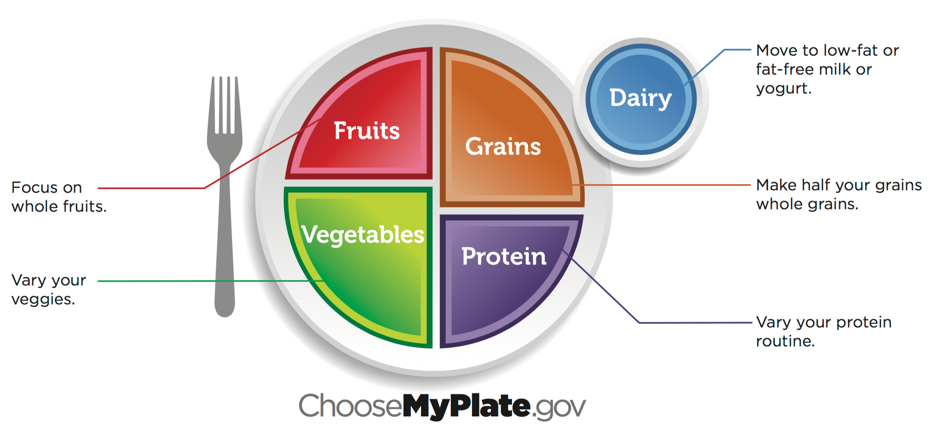
Source: https://choosemyplate-prod.azureedge.net/sites/default/files/tentips/mini_poster.pdf
Recipes
This month we have three easy recipes! The recipes come from the USDA – “What’s Cooking?” website. Below are some easy recipes that can serve as a lunch or dinner option for you or your children. They are simple, quick, and healthy!
Chicken Salad and Peach Sandwich
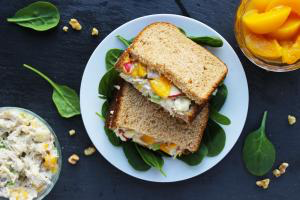
Ingredients
- 4 slices of whole grain bread
- 1/2 cup cooked chicken (diced)
- 1/2 cup canned peach slices (drained and diced)
- 1 small celery stalk
- 1/2 cup apples (Fuji, Gala, or Braeburn)
- 1 small onion
- 1 1/2 tablespoons mayonnaise (nonfat)
- 1 tablespoon chopped walnuts
Directions
- Mix together the chicken, apples, peaches, celery, onions, walnuts and mayonnaise in a small bowl.
- Spoon mixture onto 2 slices of the bread.

Falafel with Yogurt Sandwich
Ingredients
- 1 cup dry garbanzo beans (chickpeas, sorted and rinsed)
- 3 cups water
- 1/4 cup oil
- 1 garlic (clove, crushed)
- 1 onion (medium, chopped)
- 1/3 teaspoon parsley (1 sprig or about 1 teaspoon, chopped)
- 1/4 teaspoon salt
- 2 teaspoons lemon juice
- 1/3 teaspoon hot pepper sauce
- 1 cup plain yogurt (low-fat)
- 1 onion (medium, chopped)
- 4 Whole Wheat Pita bread (pockets)
- Flour to sprinkle
- tomatoes, sliced (optional)
- lettuce (optional)
Directions
- Put beans and water in large pot and soak by the overnight or quick-soak method.
- Cook until tender, about 2 hours. Add more water if necessary. Drain.
- Slowly heat oil and sauté garlic and onion until tender (5 to 7 minutes).
- Mash cooked beans, sautéed vegetables, parsley, salt, lemon juice and hot pepper sauce until smooth.
- With floured hands, form ovals with bean mixture (about 1/4 cup each). Roll in flour.
- Fry falafel, with the remaining oil in skillet, until golden brown. Drain on paper towel.
- Combine yogurt with remaining onion.
- Serve falafel in pocket bread topped with yogurt.
Chicken Salad
Ingredients
- 1 can canned chicken (drained, about 12 ounces)
- 3 tablespoons mustard
- 2 tablespoons honey
- 1 cup apples (diced)
- 1⁄4 cup raisins
- 1⁄4 teaspoon black pepper
- 2 tablespoons parsley or cilantro (chopped, optional)
Directions
- In a large bowl, combine chicken, mustard, honey, and apples. Mix well.
- Sprinkle raisins and pepper on top of salad. If using parsley or cilantro, add that too.
- Serve on a lettuce leaf or on a slice of homemade bread.

Flor De La Garza is currently pursuing a Master of Public Health degree at Baylor University. She is completing her summer practicum with Texas A&M AgriLife Extension Service in McLennan County and is working with the Better Living for Texans program. Flor is originally from Denton, TX. and has lived in Waco for about four years now. She especially enjoys learning how Waco’s organizations are working together in collaborations to reach the overall goal to improve the health and quality of life of McLennan County residents! In addition, she loves Cameron Park hiking trails, the local restaurants and food trucks!
The Act Locally Waco blog publishes posts with a connection to these aspirations for Waco. If you are interested in writing for the Act Locally Waco Blog, please email [email protected] for more information.
(As I’m sure most of you probably know, one of our Prosper Waco community goals is “McLennan County residents will live healthier lifestyles and access the best available care.” With that in mind Act Locally Waco is teaming up with Better Living for Texans to bring you a monthly blog post full of tips for healthy living. For more of the posts in this series, click here: Better Living for Texans.– ALW)
By Flor De La Garza
The belief that “eating healthy and nutritious is expensive” is a common misperception. There are several ways to save money and buy healthy foods for you and your family. Today’s focus is to provide tips and tricks to save money when buying healthy groceries by 1) identifying the in-season fruits and vegetables 2) comparing unit prices, and 3) planning meals in advance.
Know Your Seasonal Produce
You may have noticed the recent influx of watermelons, cucumbers, zucchini, corn, and many more fruits and vegetables at your local grocery store. This is because there are certain fruits and vegetables that harvest in the summer, just as there are fruits and vegetables that harvest best in other seasons (spring, fall, and winter). Knowing the “in-season” produce for each season may help you save money because the in-season food items may cost less. For example, as summer reaches its peak, you may find watermelons to be at a cheaper price than in the winter season. If your favorite produce is not in season, an alternative to eating healthy and at a cheaper price is to buy canned or frozen produce without added salt or fat. Below is a Seasonal Produce guide made with information retrieved from the U.S. department of Agriculture – SNAP Ed (https://snaped.fns.usda.gov/seasonal-produce-guide) that can serve as a guide as you shop for in-season produce next time you are shopping for groceries.
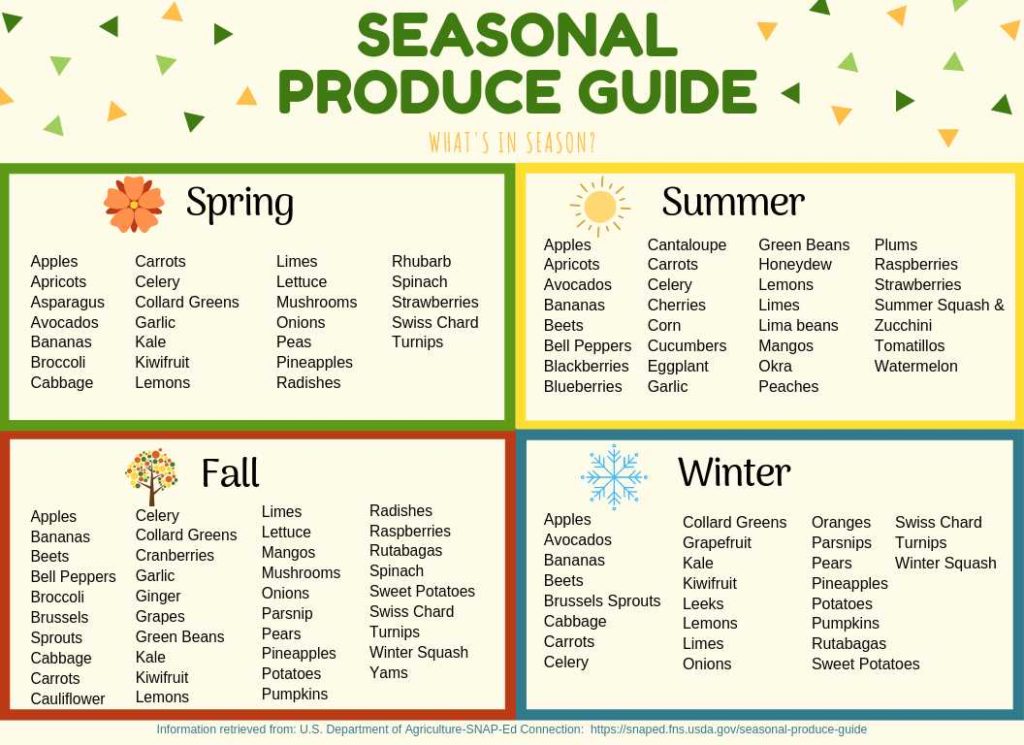
The grocery store is not the only place you can save money when shopping for produce. Starting your own garden or shopping at the farmers market is a great way to obtain inexpensive, freshly picked in-season produce. The Waco Downtown Farmers Market opens every Saturday from 9 AM – 1 PM and is located at 500 Washington Ave, Waco, TX. 76701 – you can save money, enjoy the outdoors, and contribute to local small businesses all in one trip! If you are interested in starting your own garden, the McLennan County Master Gardeners can provide you with advice, direction, and answer any questions you may have. They are available to answer your gardening questions Tuesdays and Thursdays from 1:30 PM – 4:30 PM at (254) 757-5180. You may also connect with the McLennan County Master Gardeners at the farmers market as they set up a semi-monthly booth to provide outreach on a variety of gardening topics.
Remember: fresh, frozen, canned, and dried – it all counts!
Comparing Unit Prices
To decide on the “cheaper option” within food items, one common way to compare prices is to look is to look at the total price of two items and simply compare them to determine which price is the lowest. However, this tactic may not always work because of the packaging, weight distribution, or size difference of both items. A more beneficial alternative is to compare unit prices. The unit price is the cost of an item based on a specific unit, such as a pound, ounce, or quantity per container.
Knowing the unit price can allow you to compare the cost of a food item based on brand and size. For example, (see below for picture) when buying XYZ Yogurt, it may appear that the total price of the 6-ounce (oz) yogurt is the cheaper option when compared to the 32 oz yogurt. However, when comparing the unit prices, the 32 oz yogurt is .07 cents cheaper per ounce.

Planning Meals in Advance
Scenario: You go to the grocery store. You buy some spinach, zucchini, cucumber, and corn because you know these items are “healthy” and “in-season”. You get home. Now what? You look up healthy recipes and realize you need a few more items to complete the recipe. You make a trip back to the store and buy more items than you needed. Now you are back home, and you are over your groceries budget.
The scenario above is very common. You can prevent going over your budget by planning your meals and writing a grocery list before going to the grocery store. You can plan healthy meals that use “in-season” produce and follow the MyPlate food groups (vegetables, fruits, protein, grains, and dairy). Once you arrive to the grocery, you know exactly what you need to make healthy meals for yourself and your family without being distracted by food items you may not need. In return, you will save money and prepare healthy meals!
If you have not tried these tips and tricks before, I encourage you to practice them while shopping for groceries this month! Enjoy saving money and healthy foods!
Recipes
This month we have three refreshing recipes that call for in-season produce! All three recipes are bright and refreshing for kids, teens, and adults! Feel free to pair any of the recipes to your Fourth of July celebration. The recipes come from the Texas A&M AgriLife Extension’s Dinner Tonight Program (https://dinnertonight.tamu.edu) and the USDA – “What’s Cooking?” website.
Ingredients:
For Salad
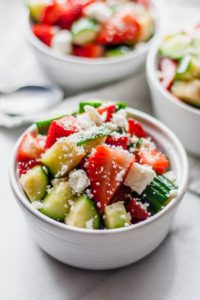
- 3 large Cucumbers skin removed, chopped
- 3 cups strawberries quartered
- 1/2 cup red onion finely chopped
- 1/4 cup basil leaves chopped
- 1/2 cup Fat Free feta cheese crumbled
For Dressing
- 1/3 cup lime juice
- 1 tablespoon olive oil
- 2 tablespoons honey
Instructions:
- Wash your hands and clean your preparation area. Rinse vegetables, fruits and herbs under cool running water before chopping.
- In a large bowl, combine the cucumbers, strawberries, red onion, and basil.
- In a small bowl or jar combine lime juice, olive oil, and honey. Whisk or shake until combined.
- Pour the dressing over the cucumber mixture and toss to combine. Top with feta cheese.
Watermelon Cucumber Balsamic Salad
Ingredients:
- 4 cups watermelon cubed
- 2 cups cucumber cubed
- 1/2 cup red onion sliced
- 1/4 cup basil chopped
- 2 tablespoon olive oil
- 1/2 cup balsamic vinegar
- 2 ounces Fat Free feta cheese crumbled
Instructions:
- Mix together watermelon, cucumber, red onion and basil.
- Mix together olive oil and balsamic vinegar then pour over the watermelon mixture.
- Top with feta cheese and enjoy!
Ingredients:

- 1 cup crushed pineapple
- 1 cup yogurt, low-fat fruit (8 ounces)
- 6 fluid ounces orange juice, frozen concentrate (thawed)
Instructions:
- Mix the ingredients in a medium-size bowl. Divide into 4 paper cups.
- Freeze until slushy – about 60 minutes. Insert a wooden stick half way through the center of each fruit pop.
- Freeze until hard or at least 4 hours. Peel away the paper cup before you eat the fruit pop.
Note: You can mix ingredients and freeze in ice cube tray instead of cups, making great “ice cubes” in fruit juice. Try other fruits or juice concentrates for variety.

Flor De La Garza is currently pursuing a Master of Public Health degree at Baylor University. She is completing her summer practicum with Texas A&M AgriLife Extension Service in McLennan County and is working with the Better Living for Texans program. Flor is originally from Denton, TX. and has lived in Waco for about four years now. She especially enjoys learning how Waco’s organizations are working together in collaborations to reach the overall goal to improve the health and quality of life of McLennan County residents! In addition, she loves Cameron Park hiking trails, the local restaurants and food trucks!
The Act Locally Waco blog publishes posts with a connection to these aspirations for Waco. If you are interested in writing for the Act Locally Waco Blog, please email [email protected] for more information.
(As I’m sure most of you probably know, one of our Prosper Waco community goals is “McLennan County residents will live healthier lifestyles and access the best available care.” With that in mind Act Locally Waco is teaming up with Better Living for Texans to bring you a monthly blog post full of tips for healthy living. For more of the posts in this series, click here: Better Living for Texans.– ALW)
By Lindsey Breunig
Summertime is here! You might be free from the classroom or still stuck in the office, but we cannot hide from the fact that with summertime comes higher temperatures. Recently I have found myself turning the fan on or up to combat the heat. As Texas begins to warm up, we need to protect our bodies from the hotter temperatures. Keep safe by remaining hydrated which means we are replacing water that has left our bodies. Today the focus is water because what better way to replace water than with water!?
Plain and simple water is critical to our overall health. It is widely accepted that humans can survive for more than a month without food, but only a few days without water. Water helps transport nutrients to working muscles, while also transporting waste products through urination, perspiration, and bowel movements. Water also helps digest our food and lubricates our joints, organs, and tissues, and protects your spinal cord and other sensitive tissues. Additionally, water keeps your temperature normal, so no wonder you need more water during the summer season! As temperatures begin to increase let’s think of ways to get more water in our diet.
While sweet drinks are delicious, it is better to choose water instead of sugar-sweetened beverages. This helps in preventing cavities and with weight management. Substituting water for one 20-ounce sugar sweetened soda will save you about 240 calories.
If you enjoy the sweet side of sodas try switching to 100% fruit juice. To reduce even the natural sugar, try to mix the juice with water. Now, before you call me crazy, (trust me it has happened) try by adding just a little water. For example, start with a ratio of ¾ juice to ¼ water – it might not taste as sweet, but you can slowly work your way to less juice and more water. Before you know the flavor is still there, sugar is reduced, and you have saved money!
If you enjoy the fizz of sodas try switching to sparkling water. There are many brands and flavors on the market but try the plain and add your own sweet flavor. Something I have done is add a splash of juice or frozen fruit that will infuse the drink. You may have seen the drink infusers at the store or online which take water to another level by adding new flavors to plain or sparkling water. When using plain water, you can let the fruit infuse over a couple hours. Think of your favorite juice combos and try to recreate! Some fruit and veggie combos to try are below:
1. Strawberries + Kiwi + Cucumber
2. Cucumber + Lemon + Lime
3. Orange + Lemon + Lime
4. Raspberries + Lemon + Mint
5. Blueberries + Lemon
In addition to drinking water, we can also get water through the foods we eat. Eating foods with high water content adds volume but minimal calories to the diet. Foods with high water content promote a feeling of fullness. Fruits and vegetables are two food groups that have generally high-water content.
Fruits that are high in water content are: watermelon, citrus fruits, grapes, apples, papaya, and strawberries. Vegetables that are high in water content are: carrots, bell peppers, lettuce, tomato, cucumber, squash, and broccoli. Did I mention a favorite? Great, stock up for the summer!
This month we have two refreshing fruit and veggie drinks to try from the Texas A&M AgriLife Extension’s Dinner Tonight program! (https://dinnertonight.tamu.edu/) The below recipes will be more flavorful than infused water but full of natural sweetness (0 grams of added sugar). Check them out and this summer, hydrate, hydrate, hydrate!
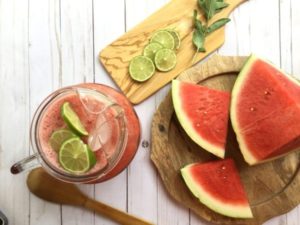
Aguas Frescas Watermelon and Lime (https://dinnertonight.tamu.edu/recipe/aguas-frescas-watermelon-and-lime/)
Ingredients:
- 5 cups seedless watermelon cubed
- 3 cups water divided
- 5-6 mint leaves
- 1 lime sliced for garnish
- 1 cup Ice
Instructions:
- Combine watermelon, 1 cup of water, and mint leaves into a blender untill liquefied.
- Pour the watermelon mixture into a 2 quart pitcher, add 2 cups of water and ice, stir together.
- Garnish the drink with thinly sliced lime rings and enjoy.
- Serve or store in refrigerator up to 2 days.
- Tip: Use a strainer when pouring the liquefied watermelon into the 2 quart pitcher for a thinner consistency.
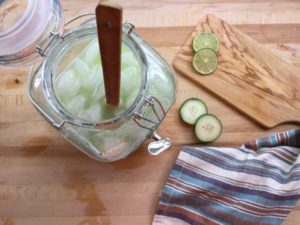
Aguas Frescas Cucumber and Lime (https://dinnertonight.tamu.edu/recipe/aguas-frescas-cucumber-and-lime/)
Ingredients:
- 2 medium Cucumbers peeled and sliced
- 5 cups water divided
- 1 Lime with peel wedged
- 1 cup Ice
Instructions:
- Combine cucumbers with 3 cups of water in blender until liquefied.
- Using a strainer over the mouth of a 2-quart pitcher, pour half of cucumber mixture slowly to strain the liquid.
- Add the wedges of a lime to the other half of cucumber mixture in blender. Blend together for a few seconds until chopped up into medium pieces. **Note: Blending the lime longer or into smaller pieces may give a bitter taste.
- Pour the remaining mixture over strainer.
- Add 2 cups of water and ice into the pitcher and stir well.
- Serve or store in refrigerator up to 2 days.

Lindsey Breunig is a graduate of Baylor University and currently works as the Better Living for Texans Educator for the Texas A&M AgriLife Extension Service. She is originally from Grapevine, TX and now calls Waco home. Here in Waco she loves to venture out to Cameron Park, visit the local Farmers Market, and try out the awesome eateries in Waco. If you see her and hear a loud bark, that’s her pup Lucy just saying hello.
The Act Locally Waco blog publishes posts with a connection to these aspirations for Waco. If you are interested in writing for the Act Locally Waco Blog, please email [email protected] for more information.
By Lindsey Breunig

Summer time is approaching, Waco is starting to heat up, and so is the grilling season! From local parks or in your own backyard, grilling out can be a tradition that brings together family and friends. Not only is grilling out a social experience but grilled meals are tasty, healthy, and economically friendly. Weather permitting, grilling gets family and friends outside, and gives you an opportunity to encourage physical activity. Rather than sitting around and waiting, use the grilling time as an opportunity to throw the softball, kick a soccer ball, or bump the volleyball. Additionally, lawn games are cheap, easy to transport, and suitable for all ages. Participating and moving around while grilling will help increase one’s strength, endurance, balance, and flexibility – all while a delicious meal is being made!
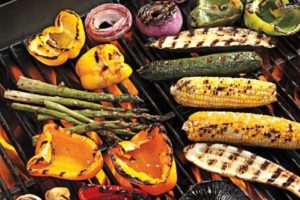
Not only does grilling out create quality time with friends and family but it is a low-fat cooking option for a variety of foods and colors on your plate. Most of our favorite foods can be grilled. This includes beef, chicken, fish, pork, and even your favorite fruits and vegetables. Grilled fruits can be delicious additions to a main dish or even desserts. Be creative and let the children pick their favorites to try out. When grilling fruits it is important to keep an eye on the grill as fruits cook quickly. In fact, you might find that even your pickiest eaters will enjoy their vegetables after the foods are grilled! To prevent sticking, it’s helpful to brush fruit lightly with oil. Interested in grilling some veggies? Here are some quick instructions:
Ingredients:
- 2 tablespoons of vegetable oil
- 2 garlic cloves (finely chopped)
- Any mix of your favorite veggies (for example: corn, eggplant, zucchini, onions, or peppers)
Directions:
1. Mix the oil and garlic in a large bowl before adding and tossing the vegetables. (For easy clean up you can use a gallon size bag)
2. Place the vegetables on a broiler pan or grill. Cook for 10 minutes, turning twice until the vegetables are tender.
3. Place the vegetables on platter and enjoy!
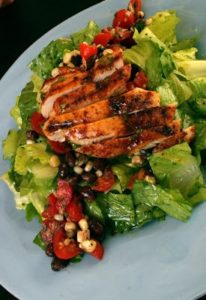
There are also economic benefits to grilling. Grilling outside will help lower high summer electric bills by not raising the inside house temperature. Grilled food makes great leftovers for the next day. Leftover meats are great in lettuce-based salads and leftover vegetables go great with scrambled eggs. Try making a tasty grilled chicken salad by adding corn, black beans, tomatoes, cilantro, lettuce, and salsa with your left-over grilled chicken. Dice the chicken up and mix with the other ingredients!
Grilling can be dangerous without taking the proper safety steps. There are an ample number of opportunities to teach family and friends about food safety while out grilling. For example: using separate plates for raw and cooked meats to avoid cross-contamination. Use tongs to turn solid pieces of meat to avoid cross-contamination and keep the juices of the meat inside. Tongs will keep your hands safe but also remember to keep your hands clean and away from the hot grill or flame. Heat the grill for 10-15 minutes before adding food so foods will be seared instead of steamed or baked. Finally, assure your food is safe to eat by cooking your food to the minimum internal temperature throughout. Use a food thermometer (not your eyes) to make sure meats are fully cooked. Beef, pork, veal, and lamb (steaks, roasts, and chops) should be cooked to a minimum internal temperature of 145 degrees, while ground beef, pork, and veal should be cooked to a minimum temperature of 155 degrees. All poultry should be cooked to a minimum of 165 degrees.
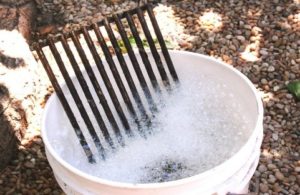
Whether you use a gas, charcoal, or electric grill, it is important to follow the operating directions carefully and keep your grill in a safe place to avoid accidents. To help get the most out of your grilling experience remember to clean your grill before cooking. To clean your grill, remove the grates and wash in hot, soapy water. Scrub off any food particles or drippings with a brush or scrubbing pad. Rinse with clean water and air dry. Remember to remove and clean, or replace, the drip pan. Clean the outside of the grill with hot, soapy water and rinse clean. Follow the manufacturer’s instructions for cleaning the burners and interior of the grill.
Create safe habits that friends, family, and even children know, and you will be one step closer to a great day grilling out. Below is a graphic from the Centers for Disease Control and Prevention that you can share with friends and family! Happy Grilling Season!
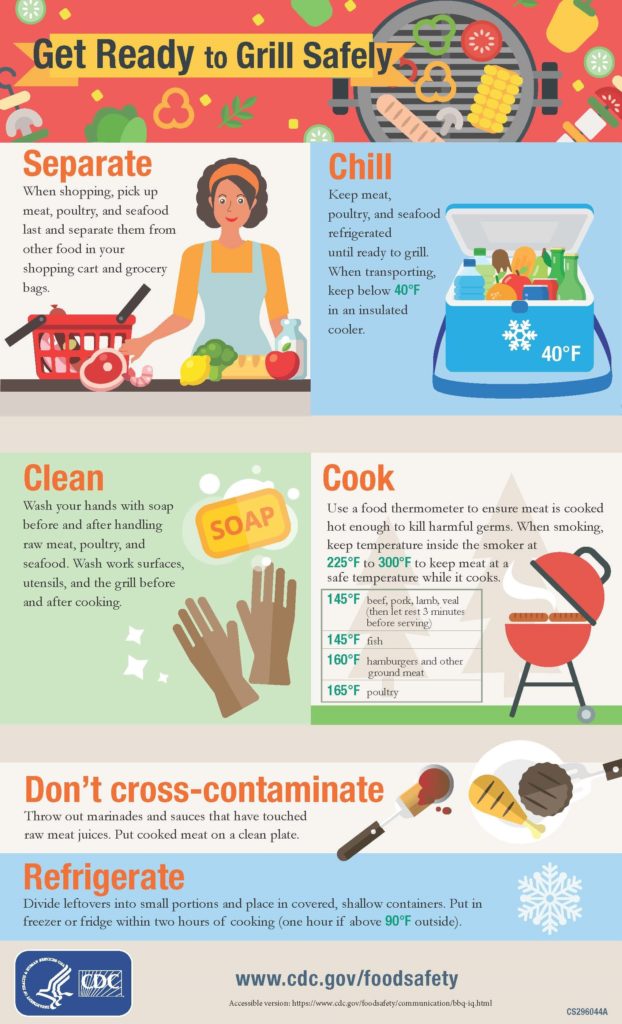

Lindsey Breunig is a graduate of Baylor University and currently works as the Better Living for Texans Educator for the Texas A&M AgriLife Extension Service. She is originally from Grapevine, TX and now calls Waco home. Here in Waco she loves to venture out to Cameron Park, visit the local Farmers Market, and try out the awesome eateries in Waco. If you see her and hear a loud bark, that’s her pup Lucy just saying hello.
The Act Locally Waco blog publishes posts with a connection to these aspirations for Waco. If you are interested in writing for the Act Locally Waco Blog, please email [email protected] for more information.
By Kelli Niemeier
Spring, egg hunts, candy, bunnies, and delicious family meals. These festive events are the hallmark of the month of April. With Easter coming up soon, it is important to remember some important food safety techniques to have a safe and happy holiday! A report by CNN News stated that Americans are “egg-spected” to purchase about 180 million eggs for consumption or decoration during the Easter season. That’s a whole lot of eggs! So, let’s get crackin’ on important things to remember when buying, storing, and cooking all those eggs!
Buying Eggs
When you’re buying eggs at the grocery store, always check the carton before you put it in your cart. Why? Bacteria from dirt or chicken droppings on the outside of the shell can enter the egg through cracks that are sometimes too fine to see. Before you purchase eggs, there are several steps to consider:

- Open the carton and check the eggs look clean and are not cracked before purchasing.
- Buy only eggs that are sold from a refrigerator or refrigerator case.
- Do not switch eggs from one carton to the other. Eggs are labeled according to the U.S. Department of Agriculture (USDA) with the location the eggs were processed. If you switch the eggs, you won’t know where the eggs are from or how they have been stored and handled.
- Check the expiration date and/or sell by date of your eggs before purchasing. The three-digit code after the plant number is the Julian Date of Pack. This number indicates the consecutive date of the year on which the eggs were packed. Example: Jan 1 = 001, July 1 = 182, and Dec 31 =365.
Following these tips before purchasing will ensure that you are buying eggs that will remain fresh!
How Long Should I Keep Eggs?

After you purchase your eggs, refrigerate the eggs in their original carton. Place the carton in the refrigerator, rather than in the door. For best quality, use your eggs within 3-5 weeks of the date you purchased them. Just because the ‘sell-by’ date has already passed does not mean your eggs are not safe to use. You may have heard of the tip to put your egg in a bowl of water to see if it is still fresh. You can simply add water to a bowl (enough to submerge an egg completely) and place it in the water. A fresh egg sinks, whereas an older egg will float. As time passes, eggs develop tiny pockets of air beneath the shell, so after time, the egg will float! An egg may float in water because it is older, but it still may be perfectly safe to use. Crack the egg into a bowl and look for an off-odor or unusual appearance.
Easter Egg Safety Tips
- If you’re having an Easter egg hunt, consider hiding places carefully. Avoid areas where the eggs might come into contact with pets, other animals, or lawn chemicals.
- Make sure you find all the eggs you’ve hidden and refrigerate them. Discard any cracked eggs.
- If the eggs have been out of refrigeration for more than two hours, they are NOT safe to eat. If the eggs have been out of refrigeration for less than two hours, they ARE safe to eat.
- Make sure your eggs are cooked thoroughly. Cook eggs until both the yolk and white are firm. Casseroles and other dishes with eggs should be cooked to 160˚F. Always use a food thermometer to make sure they are thoroughly cooked. For more information about avoiding food borne illness and other egg safety facts click here.
An Egg-cellent Source of Protein
Eggs are a terrific source of protein and healthy fats. Eggs contain vitamins D, A, B2 and B12, and are also a source of minerals such as folate and iodine. The white of an egg is where more than half of its protein is found. This part of the egg is a good source of selenium, zinc, iron, and copper. The yolk is where the fat from the egg is stored. The egg yolk is a great source of vitamins D, E, K, and A. For more information about the health benefits from eggs, click here. Eggs are often used around the Easter season, but they’re also a versatile food that can be enjoyed year-round for breakfast, lunch, and dinner. Here’s a deviled egg recipe that is easy and cheap. Short on time? Look no further than this quick and simple recipe for microwavable scrambled eggs. I hope these tips helped you learn a thing or two about some food safety and health tips to start off the month of April!

Kelli Niemeier is a Nebraska native who is pursuing a Master of Public Health degree at Baylor University. She is currently an intern with Texas A&M AgriLife Extension Service in McLennan County and is working with the Better Living for Texans program. She is passionate about empowering communities to improve health and well-being. Kelli has learned to call Waco her home away from home. She especially enjoys the small-town atmosphere and charm of Waco and trying local food. Kelli is also an adventurer at heart who loves to visit U.S. National Parks!
(As I’m sure most of you probably know, one of our Prosper Waco community goals is “McLennan County residents will live healthier lifestyles and access the best available care.” With that in mind Act Locally Waco is teaming up with Better Living for Texans to bring you a monthly blog post full of tips for healthy living. For more of the posts in this series, click here: Better Living for Texans. – ALW)
By Kelli Niemeier
Like most people, you’ve probably heard that physical activity, including exercise, is good for you. If you’re already active, keep up the good work! It may even be time to push yourself a little harder, try a new activity, or find new ways to add exercise to your daily life.
Why is Physical Activity Such a Big Deal?
Exercise and physical activity are important to the physical and mental health of almost everyone. Being physically active can reduce the risk of developing some diseases and disabilities later in life. In some cases, exercise is an effective treatment for many chronic conditions. For example, studies show that people with arthritis, heart disease, or diabetes benefit from regular exercise. It can also help with high blood pressure, balance problems, or difficulty walking.
What’s the Difference Between Physical Activity and Exercise?
Both terms refer to the voluntary movements you do that burn calories. Physical activities are activities that get your body moving. This could be gardening, walking the dog, raking the leaves, or taking the stairs instead of the elevator. Exercise is a form of physical activity that is planned, structured, and repetitive such as weight training or an aerobic class. Both physical activity and exercise are important and can help improve your ability to perform everyday activities. In fact, exercise and physical activity benefit every area of your life. They can:
- help maintain and improve your physical strength and fitness
- help improve your ability to do the things you want to do,
- and help you improve your mood and overall well-being.
You probably noticed the key word is you! Whatever your abilities are, the key is to match your physical activity to your own needs and abilities. For some people, swimming can be a great alternative to running for an aerobic exercise. For others, a slow walk around the corner and back is a big achievement.
As a guideline, the Centers for Disease Control (CDC) recommends that we get 30 minutes of physical activity per day. Does that mean that you need to go on a 30-minute run? No! You can break up your physical activity throughout the day such as 10-minute intervals. Remember to find activities that you enjoy. If you don’t enjoy what you’re doing, more than likely, you won’t stick to it! Find friends in your community to be physically active with. Making exercise and physical activity social could help to reinforce your behaviors.
What’s New with Physical Activity in Waco?
Get into the habit of getting healthy with a FREE 8-week Walk Across Texas Program. The Texas A&M AgriLife Extension Service created this annual program to help Texans increase physical activity. The program is designed for teams and individuals to register to walk the 832-mile goal of essentially walking across the great state of Texas. This program is ideal for families, friends, children, and organizations to encourage physical activity. For questions, FAQs, and to register click here http://walkacrosstexas.tamu.edu/. Grab your tennis shoes because Walk Across Texas officially started on March 4 here in McLennan County!
Pairing Physical Activity with a Healthy Lifestyle
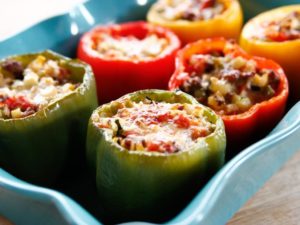
Of course, we can talk about the importance of physical activity all we want, but let’s not forget the role that other aspects of our lifestyle play into our overall well-being. This includes getting 8 hours of sleep every night, finding ways to reduce stress, and eating a healthy, balanced diet. For a healthy diet, try to increase fruit and vegetable consumption, eat sensible portions, and enjoy your food! Check out this stuffed bell pepper recipe that is sure to impress! (BONUS: This recipe serves up to 8 people with a cost per serving of $0.89!)

Kelli Niemeier is a Nebraska native who is pursuing a Master of Public Health degree at Baylor University. She is currently an intern with Texas A&M AgriLife Extension Service in McLennan County and is working with the Better Living for Texans program. She is passionate about empowering communities to improve health and well-being. Kelli has learned to call Waco her home away from home. She especially enjoys the small-town atmosphere and charm of Waco and trying local food. Kelli is also an adventurer at heart who loves to visit U.S. National Parks!
By Lindsey Breunig
It is difficult to avoid Valentine’s Day reminders. There are decorations, cards, and candy in every store, and the radio, TV, or social media ads tend to highlight a gift for that special someone. Many restaurants might even have a special menu to celebrate the holiday. Whether you love the tradition or would prefer to avoid all things red that day, this post is dedicated to starting a new tradition on February 14th, a heart-healthy tradition. This Valentine’s Day give something from the heart for the heart!
The National Institute of Health estimates that the heart will beat 3 billion times in an average human lifetime. How amazing is that! The heart pumps blood through the network of arteries and veins supplying the body with oxygen and nutrients essential for our survival. It is no wonder why we need to take care of our heart!

During this time of year, it’s easy to get caught up to get the perfect gift to convey our love to those special people in our lives. While it may be nice to give (and receive) a box of chocolates, an even greater show of love is to share a heart-healthy gift to let the those know you care. Instead of offering an over-sized piece of cake or a box of sweets, give something that takes care of the heart. Below are some fun recipes to make for someone you care about.
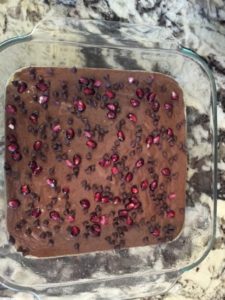
For all the chocolate fans reading this, here is a recipe for brownies with some extra twists! For Valentine’s Day try making these Chocolate Pomegranate Brownies. The chocolate and pomegranate create a delicious combination! Additionally, these brownies are made with black beans and prunes that you cannot taste.
Including fruit in dessert is a great way to get sweet flavors while also intaking wonderful vitamins and minerals. You can experiment with your favorite recipe by using unsweetened applesauce or mashed ripe bananas instead of butter. Or, try baked apples or peaches with cinnamon and a sprinkle of sugar instead of pie.
Like fruits, vegetables provide us with many vitamins and minerals that are great for our body. This next recipe is a favorite and uses red tomatoes to keep us in the Valentine’s Day spirit! Tomatoes are high in lycopene which according to the Harvard Medical School is a powerful antioxidant that eliminates dangerous free radicals that can damage DNA and other fragile cell structures. How thoughtful of you to use tomatoes this Valentine’s Day! Enjoy this Cowboy Salad.

Our final recipe is sure to impress! This easy pork tenderloin with a cayenne cherry sauce is healthy, while still feeling indulgent. Additionally, this recipe is stamped with the American Heart Association® Heart-Check Mark. The Mark helps consumers recognize that the recipe meets Heart-Check nutrition requirements that limit saturated fat, trans fat, sodium and added sugars, and promote consumption of beneficial nutrients. Check out this Pork Tenderloin with Cayenne Cherry Sauce or watch here.
The menu is set and now it’s time to include some physical activity as part of your Valentine’s Day! In addition to eating food that is good for our heart and bodies, remember it is also beneficial to have an active lifestyle that includes regular exercise to improve or maintain heart health. After a meal have fun walking around Waco with family and friends and think about gifts that encourage healthy habits such as running shoes, or reusable water bottles. Time together allows you to laugh, mingle, dance, and play games. Focus on fun and enjoy the company of others. I hope this Valentine’s Day is a lovely day for everyone and their heart!

Lindsey Breunig is a graduate of Baylor University and currently works as the Better Living for Texans Educator for the Texas A&M AgriLife Extension Service. She is originally from Grapevine, TX and now calls Waco home. Here in Waco she loves to venture out to Cameron Park, visit the local Farmers Market, and try out the awesome eateries in Waco. If you see her and hear a loud bark, that’s her pup Lucy just saying hello.
The Act Locally Waco blog publishes posts with a connection to these aspirations for Waco. If you are interested in writing for the Act Locally Waco Blog, please email [email protected] for more information.
(As I’m sure most of you probably know, one of our Prosper Waco community goals is “McLennan County residents will live healthier lifestyles and access the best available care.” With that in mind Act Locally Waco is teaming up with Better Living for Texans to bring you a monthly blog post full of tips for healthy living. For more of the posts in this series, click here: Better Living for Texans. – ALW)
by Lindsey Breunig
 Traditionally the November and December months are packed with celebrations and fun, with food at the center every time. We enjoy the holidays but quickly regret the after-effects when looking at our post-holiday waistlines. From the special meals, tasty treats, and delicious desserts, it’s easy to take in extra calories during the holidays. A small snack here and another there, combined with a large dinner and dessert, can add up to a few extra pounds. Not to mention the office party, friend gathering, or cookie decorating that come up! Fortunately, there are things we can do to discipline ourselves during the holidays. Below is a checklist to prevent overeating while having a wonderful holiday season:
Traditionally the November and December months are packed with celebrations and fun, with food at the center every time. We enjoy the holidays but quickly regret the after-effects when looking at our post-holiday waistlines. From the special meals, tasty treats, and delicious desserts, it’s easy to take in extra calories during the holidays. A small snack here and another there, combined with a large dinner and dessert, can add up to a few extra pounds. Not to mention the office party, friend gathering, or cookie decorating that come up! Fortunately, there are things we can do to discipline ourselves during the holidays. Below is a checklist to prevent overeating while having a wonderful holiday season:
- Eat slowly so your body has more time to signal fullness.
- Eat a small to medium-sized breakfast and lunch during the day and drink lots of water. Starving yourself in anticipation for the main meal will lead to overeating.
- Use a smaller plate to control your portion size. (Try a 9inch plate!)
- If you have many foods to choose from during the main meal, keep the size of your portions in mind. If you want to try everything, do so in moderation so that your portion sizes don’t get out of control.
- Be physically active on a daily basis (walking, jogging, biking, etc.) – our goal is 30 minutes every day!
- Make sure half your plate has fruits and vegetables.
- Look at your plate for a variety of colors represented from the different food groups.
- Try new fruits and vegetables to bring a bit more excitement into traditional meals.
 Involve your kids in meal preparation.
Involve your kids in meal preparation.- Don’t be afraid to have that slice of pie or cake. However, when enjoying your desserts try having a small sliver instead of a large slice.
- Beverages: drink water with your meals rather than sodas, or holiday drinks like eggnog which can be high in fat, sugar, and calories. Alcohol or sweetened beverages should be consumed in moderation.
Don’t get complacent. Remain disciplined in your approaches to eating healthier and engaging in physical activity. It’s much easier to break a habit than to start one, so stay engaged and committed and have a great rest of your 2018!
December Produce and Recipes
Shopping for seasonal produce means cheaper, tastier, and healthier produce. Look for these products at the Farmers Market or grocery store this December: Beets, broccoli, brussels sprouts, cabbage, cantaloupes, carrots, celery, cucumber, grapefruit, greens, herbs, honeydew, mushrooms, oranges, bell peppers, spinach, squash, sweet potatoes, tomatoes, turnips.
Recipes to try:
Cranberry Crunch Salad: Cranberry Crunch Salad is filled with winter time favorites such as cranberries, brussel sprouts,  quinoa and pecans.
quinoa and pecans.
Roasted Brussels Sprouts, Potatoes, and Chicken: This all in one sheet pan meal was easy and very tasty! We made this dish and it was a hit!
Grapefruit Salad and Vinaigrette: Did you know that the official state fruit of Texas is grapefruit? Here the whole grapefruit is used by including it in the salad and the delicious vinaigrette.
 Lindsey Breunig is a graduate of Baylor University and currently works as the Better Living for Texans Educator for the Texas A&M AgriLife Extension Service. She is originally from Grapevine, TX and now calls Waco home. Here in Waco she loves to venture out to Cameron Park, visit the local Farmers Market, and try out the awesome eateries in Waco. If you see her and hear a loud bark, that’s her pup Lucy just saying hello.
Lindsey Breunig is a graduate of Baylor University and currently works as the Better Living for Texans Educator for the Texas A&M AgriLife Extension Service. She is originally from Grapevine, TX and now calls Waco home. Here in Waco she loves to venture out to Cameron Park, visit the local Farmers Market, and try out the awesome eateries in Waco. If you see her and hear a loud bark, that’s her pup Lucy just saying hello.
- « Previous
- 1
- 2
- 3
- 4
- Next »

